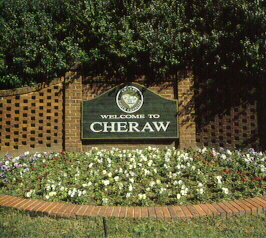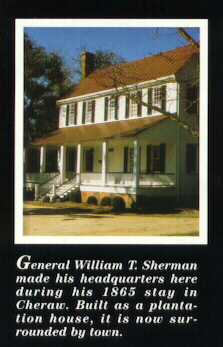Cheraw, the prettiest town in Dixie

The Cheraw and Pee Dee Indians were the earliest known inhabitants of
what is now Chesterfield County. Of Eastern Siouan stock, the Cheraws were
the dominate tribe in the upper Pee Dee at the time of the arrival of the
first Europeans. They reached the height of their power around 1650 and
maintained a well fortified village on the river hill close to present
day Cheraw. Diseases acquired from the early Spanish expolorers, DeSoto
and Juan Perdo, and then other European travelers, greatly decimated their
population, which resulted in them consolidating with the Catawba Indian
Nation, leaving only their names, well established trading routes, and
by the time of the Revolution, a few scattered families.
The first large group to come to the upper Pee Dee were Welch Baptists,
who not finding the religious freedom sought for in Pennsylvania, applied
for and was granted a large tract of land on both sides the Great Pee Dee
River above the Queensborough Township extending into current day North
Carolina. Their initial settlement in 1736 was on the east side of the
Pee Dee River in present day Marion County, but as more of the Welch Baptist
arrived, they began a more permanent settlement on the west side of the
River at Society Hill, in Darlington County. As the Welch moved in, settlers
that were already there sought permission to stay on land previously granted,
or in the case of James Gillespie, moved up the River. This Gillespie did,
and he started a trading center and water mill at the Cheraw Hills. He
is reportedly the first to bring a ship for the purpose of trading to the
Cheraw area. As the "Welch Neck" grew, development continued
along the river and eventually concentrated around the convergence of the
old Indian trading paths at Cheraw. By 1750, Cheraw was one of six places
in South Carolina appearing on English maps and was an established village
with a growing river trade.
Joseph and Eli Kersaw came to the area in 1750, and were granted most
of the present town in 1766. This is the same family who established the
first store in "Pine Tree" settlement, which became Camden, the
oldest inland city in South Carolina. Eli was a surveyor, and in 1768,
he and Joseph laid out the present street system. High Street was the highest
point in town; next came 5th and 4th Street whose
names were changed to Huger and Greene after the Revolutionary generals;
then 3rd Street, and Front Street.
St. David's Episcopal Church

The streets perpendicular to these were Church Street, where Old Saint
David's Church, established circa 1770, the last Anglican Church built
in South Carolina, is located, Market Street, for the location of the Market
hall, and Kerhaw Street after the two brothers. In 1830, the streets were
lined with elm trees, one row on each side and one row down the middle.
For a time, the town was called "Chatham" after William Pitt,
the Earl of Chatham. It was also known as Cheraw Hill, but Cheraw was always
used most frequently and that has been its name since incorporation in
1821.
Cheraw is located as high up the Great Pee Dee River as is possible
and still navigate the River. Thus it was long a trading center, though
corn, tobacco, rice and indigo were grown in the richer areas of the county,
and cattle raising, with related tanning and curing industries, was a major
source of income. Prior to the War Between the States, both the largest
cotton market between Georgetown, SC, and Wilmington, NC, and the largest
bank in South Carolina, outside of Charleston, were located in Cheraw.

The town had been occupied by the British, during the American War of
Independence, who didn't like the climate, (many of them died in fact and
are buried at St. David's) and by General Sherman and his troops, the first
week of March 1865, during his march through the Carolinas. At Sherman's
approach to the town, the Confederate Army crossed over the Pee Dee River
Bridge and it was "Uncle Henry" Funderburk, a 16 year old native
of the Dudley community, who was sent back onto the bridge to set it on
fire under heavy gunfire. They found Cheraw "a pleasant town and an
old one with the Southern aristocratic bearing" . It was here that
Sherman's own men accidentally set off an explosion rattling the city.
"John Arebuckle, a diarist of the 4th Iowa, recorded Sherman's reaction:
'General Sherman was thoroughly aroused and was on the point of ordering
the city reduced to ashes, and the major and other city officials placed
before a firing squad before it was found they weren't to blame'."
(Sherman's March by Burke Davis, page 203-204) It was also here that Sherman
ordered the murder of James Miller, a confederate soldier returning home,
and a Jefferson native, in retaliation for the death of a northern forager.
Today Cheraw is a prosperous community with a population of 5,600 with
many evidences remaining of a gracious past. Located three miles south
of Cheraw, the 332 acre Cheraw State Park offers family recreation facilities.
The park, surrounded by tall pines and sand hills, has clear fresh water
lakes which provide fishing and swimming areas, and home to the annual
Palmetto Regatta Boat Race with national championship drivers in hydroplane
speed boats competing for cash prises. Other facilities in the park are
campgrounds, vacation cottages, nature trails, recreation buildings and
picnic facilities. For more information and brochures with many pictures
of Cheraw's historic and recreational wealth, one can write to: The Greater
Cheraw Chamber of Commerce; 221 Market Street; Cheraw, SC; 29520.
|